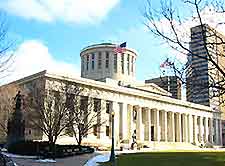Columbus History Facts and Timeline
(Columbus, Ohio - OH, USA)

Few cities begin their life destined to be a state capital, but Columbus was built explicitly to house the Ohio state legislature. Once it was integrated into the newly formed national canal and rail transportation network, Columbus and its early history burst into life with a flood of European immigrants and a strong economy based around trade and manufacturing.
In later years, it emerged as the Midwest hub for America's first aviation sector. Now the country is waiting to see what role Ohio's capital will play in its next chapter.
Ohio Country
Before the United States was created, Columbus was a part of Ohio Country, a wild land under French control, where trappers and traders came to get rich through the fur trade. The territory had always been a hotbed of violence and conflict between Native Americans and Europeans, French and English, and finally, English and American colonists. Dozens of battles, massacres and other tragic events up until the Revolutionary War are marked by battlefields and memorials in the area.
Capital City
The history of Columbus only began in 1812, when the Ohio state legislature chose the city as the site of its new capital. From the very beginning, Columbus was laid out and organized to be a state capital, but it wasn't until the city was connected to America's burgeoning transport network that anyone bothered to migrate here.
In 1831, the Ohio and Erie Canal waterway links, along with the connection to
Baltimore on the east coast via the National Road, breathed life into the city and laid the foundations for the city's development. A wave of European migrants flooded into the city, particularly German and Irish fortune-seekers. A lot of downtown construction happened around this time in history, resulting in grand projects like the Union Station and the Ohio Statehouse.
Shift Towards Manufacturing
During the Civil War, Columbus was one of the largest prisoner of war camps in the North for captured Confederate soldiers. More than 2,000 Confederate soldiers are buried in today's Hilltop neighborhood, making this one of the biggest cemeteries of its kind in the North. But with victory come the spoils, and by the turn of the 20th century, Columbus was shaping its history towards manufacturing. Taking advantage of the growing interest in personal transportation, it became the buggy capital of the world thanks to its 24 buggy and carriage factories.
Early Eco-city
In 1908, the city was home to the Columbus Project, a radical environmental program to build an urban water filtration plant that could supply a major city. Other forward-thinking ideas included its electric streetcar system that earned it the nickname the 'Arch City', after the wooden arches spanning the High Street that provided the electricity. Steel replicas of the arches have been restored in the Short North historic district.
Local history is also intertwined with America's aviation roots. The Wright brothers flew the world's first commercial flight from Columbus in 1910 and less than two decades later, Port Columbus Airport was serving as the midway station for rail-to-air transcontinental transportation. The year 1964 saw the first woman complete an around-the-world solo flight, departing from the city in the Spirit of Columbus.
 Few cities begin their life destined to be a state capital, but Columbus was built explicitly to house the Ohio state legislature. Once it was integrated into the newly formed national canal and rail transportation network, Columbus and its early history burst into life with a flood of European immigrants and a strong economy based around trade and manufacturing.
Few cities begin their life destined to be a state capital, but Columbus was built explicitly to house the Ohio state legislature. Once it was integrated into the newly formed national canal and rail transportation network, Columbus and its early history burst into life with a flood of European immigrants and a strong economy based around trade and manufacturing.